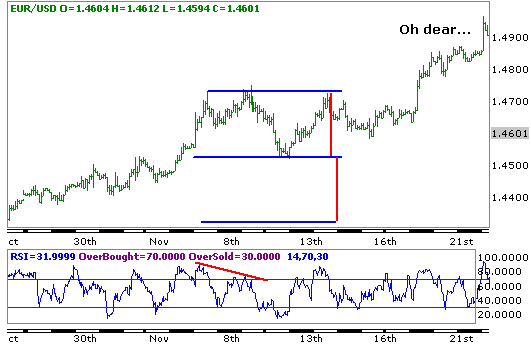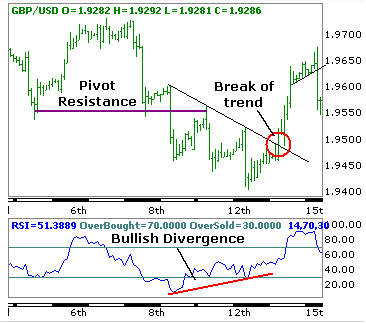When it comes to cooking, there is more than one recipe for making delicious spaghetti sauce. When it comes to trading, the same is true—more than one way exists to design a successful trading strategy.
At one time or another, every trader or investor has been taught that the smart thing to do is maintain a 2-to-1 risk-reward ratio or better. This means that for every $100 risked on a trade, the return should be at least $200. For some traders, this type of money management will work, but for others who have seen at least one of their profitable trades reverse violently and eventually be stopped out, this type of risk-reward ratio is idealistic, not realistic.
In fact, trying to maintain a 2-to-1 risk-reward ratio could be hindering many unprofitable traders from turning profitable. Not many people realize that 1-to-1 risk-reward ratios can still yield positive results in the forex market, as long as one has a high-probability trading strategy.
HIGH PROBABILITY VS. HIGH PROFIT
For a 1-to-1 risk-reward ratio to work, one needs a high-probability trading strategy that is successful at least 65 percent to 70 percent of the time. This is not impossible, especially if the trader is an ultra short-term trader who is only looking to make a small amount of pips. However, in order for it to be net positive, more than half of the trades must be winners. For example, if one plans to risk 20 pips on every currency trade, with a return of only 20 pips, 50 percent of the trades would need to hit their profit targets in order for the trader to break even. Sixty percent of the trades would need to hit their profit targets to make 40 pips. If 70 percent of the trades were winners, then the trader would be up 80 pips on every 10 trades.
Here is an example of a high-probability trading strategy that is loosely based on the momentum strategy in the second edition of my book Day Trading the Currency Market. In this strategy, one is simply looking for the price to break the 20-period simple moving average on a closing basis and for the moving average convergence divergence to confirm the direction of the trade in the last five bars (the strategy uses five-minute charts).
More specifically, if the currency pair closes above the moving average, and MACD has crossed from negative to positive within the last five bars, then one goes long the currency pair. If the price closes below the moving average and MACD has crossed from positive to negative within the last five bars, then one goes short the currency pair. Thirty pips are risked on each trade, for a return of 30 pips.
As shown in the following example of the British pound/U.S. dollar (GBP/USD), four out of the five trades were profitable for a net return of 90 pips and an accuracy rate of...80 percent (see Figure 1):
• No. 1, long GU@1.4914 , TP@1.4944 , resulting in +30 pips.
• No. 2, short GU@1.4925, TP@1.4895, resulting in +30 pips.
• No. 3, long GU@1.493, TP@1.496, resulting in +30 pips.
• No. 4, short GU@1.4915, TP@1.4885, resulting in +30 pips.
• No. 5, long GU@1.4905, SL@1.4875, resulting in -30 pips.
With a high-profit trading strategy on the other hand, the success rate can be far lower as long as the risk-reward ratio is high. If one has a trading strategy that risks 50 pips for a return of 150 pips on every currency trade, that trader would only need to be successful 30 percent of the time to be net positive. In other words, if seven out of 10 trades were losers and three were winners, the net return would still be 100 pips.
A moving average crossover strategy is typically a high-profit but low-probability trading strategy. Figure 2 is an example of a strategy that is based on a 10- and 20-hour simple moving average crossover. In this strategy, a trader goes long the currency pair when the 10-hour SMA crosses above the 20-hour SMA. The trade remains open until the currency pair breaks the 20-hour SMA. For a short trade, the guidelines are reversed. The currency pair is sold when the 10-hour SMA crosses below the 20-hour SMA; the exit rule remains the same.
As seen in the following example of the Australian dollar/U.S. dollar (AUD/USD), four out of the five trades were unprofitable for an accuracy rate of only 20 percent, but the net return was still 25 pips (see Figure 2):
• Trade No. 1, short AUD/USD: Enter at 0.6465, exit at 0.6485, resulting in -20 pips.
• Trade No. 2, long AUD/USD: Enter at 0.653, exit at 0.647, resulting in -60 pips.
• Trade No. 3, short AUD/USD: Enter at 0.647, exit at 0.6495, resulting in -25 pips.
• Trade No. 4, long AUD/USD: Enter at 0.652, exit at 0.647, resulting in -50 pips.
• Trade No. 5, short AUD/USD: Enter at 0.638, exit at 0.62, resulting in +180 pips.
The difference between a high-probability and a high-profit trading strategy is that one focuses on small, consistent wins, while the other swings for the fences. Both can yield positive results in their own right, but swinging for the fences is the most common way to trade and may also be the reason many novice traders have a tough time staying alive in the currency market. With a high-profit trade, which is characteristic of picking tops and bottoms, one may need to be able to survive several misses before one hits the big winner.
Unsurprisingly, high-probability trading is usually synonymous with shorter-term trading, while high-profit trading usually applies to longer-term trades.
Of course everyone hopes to find a trading strategy that has both a high probability and high profit, but doing so may be as difficult as finding the holy grail.
TWO-LOT METHOD
One way to increase the probability of winning trades is to follow the two-lot method that I use. In 2008, 80 out of the 103 trades were winners, for an accuracy rate of approximately 78 percent. Each trade always has a short target and a long target, which means that I trade in multiples of two. The first target is usually easily achievable, while the long target is two to three times the risk. I always trail the stop as the trade progresses to lock in profits because my trading motto is never let a winner turn into a loser. The trades are always based on a combination of fundamental and technical analysis.
By trading more than two lots, a trader exposes oneself to double the risk because if his or her stop is 50 pips away from the entry, for example, and he or she is stopped out on two lots, the real loss is 100 pips. This is why it is absolutely necessary to make sure that a trader is confident in his or her high-probability trading strategy. If one is relatively certain that he or she can make 10 pips a day for example, then the trader should stick with that target and just adjust the trading size.
TWO TRADERS, ONE RESULT
The type of trading strategy that one has is just as important as the trade management used. In the currency market, technical analysis is hands down the most popular way to analyze currencies. Both new and seasoned traders will spend the majority of their time looking at chart patterns, drawing Fibonacci levels, counting Elliott waves or creating their own combination of indicators with the ultimate goal of developing a trading strategy that gives the perfect entry signal.
Based on my experience, however, the exit is just as important as the entry. A few years ago, I remember talking to Rob Booker, a fellow currency trader, about the importance of entries and exits and which is more important. Booker told me that posing that question was like asking a pilot which is more important: the take off or landing. I am sure that almost anyone who has ever been on a plane would agree that both are important. That is why every single one of my trading strategies uses the two-lot method.
While working at JPMorgan Chase, I once traded alongside two extremely talented FX traders. They went long and short the EUR/USD at the same time and, interestingly enough, both ended up making money. The trader who went long euros traded off of five-minute charts and held his position for no more than 20 minutes, while the trader who went short euros traded from one-hour charts and held his position for four hours. The reason both traders were able to make money, even though they had conflicting positions, is because of trade management.
I strongly believe that the management of the trade is critical to successful trading, regardless of whether one practices high-probability or high-profit trading. Traders often lament the many times they should have locked in profits or moved their stops.
As in cooking, there is always more than one
recipe for trading success, and if traders are frustrated with trying to adhere to a 2-to-1 risk-reward ratio, high-probability trading may be a better method for them.
If you like this post, jump in our subscriptions
Forex Trading Currency by filling your email
and get the
Market Watch indicator bonus instantly at the bottom of the confirmation email!
Author Kathy Lien is an internationally published author and the director of currency research at FX360.com and GFT Forex. The second edition of her book Day Trading and Swing Trading the Currency Market was released in Dec 2008.





























